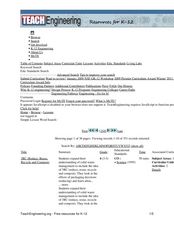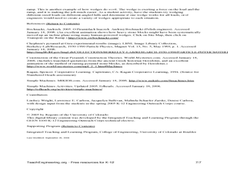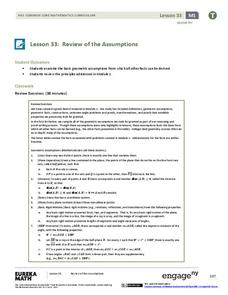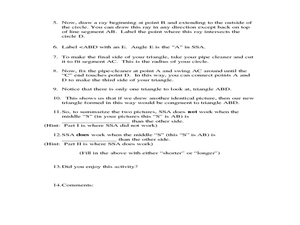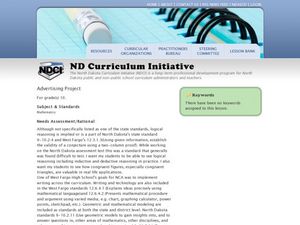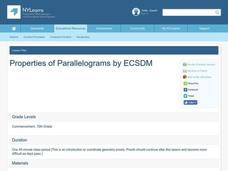EngageNY
Three-Dimensional Space
How do 2-D properties relate in 3-D? Lead the class in a discussion on how to draw and see relationships of lines and planes in three dimensions. The ability to see these relationships is critical to the further study of volume and...
EngageNY
How Do Dilations Map Segments?
Do you view proofs as an essential geometric skill? The resource builds on an understanding of dilations by proving the Dilation Theorem of Segments. Pupils learn to question and verify rather than make assumptions.
Curated OER
Getting it Right! An Investigation of the Pythagorean Theorem
In order to learn about the Pythagorean Theorem, young mathematicians investigate relations and patterns between different sides of a right triangle to look for possible relations among the squared sides. Once they have established the...
Curated OER
Let's Move It!
Students create a simple machine that includes a cart and lever system that could have been used to build the ancient pyramids. In this simple machine lesson, students learn about the wheel and the axle as simple machines that help...
Mathematics Assessment Project
Square
Don't be a square! Young mathematicians determine the slope and length of a line segment. They then prove whether four given coordinate points form a square.
Virginia Department of Education
Lines and Angles
Explore angle relationships associated with transversals. Pupils construct parallel lines with a transversal and find the measures of the angles formed. They figure out how the different angles are related before constructing...
Shodor Education Foundation
Surface Area of Rectangular Prism
With this interactive instructional activity, learners compute the surface area of rectangular prisms. They visit an online investigation applet and record data on the provided handout. Pair this instructional activity with the volume...
Curated OER
Pyramid Building: How to Use a Wedge
Learners explore the simple machine of a wedge. In this wedge lesson, students test wedges on different materials including wax, soap, clay and foam. They learn how a wedge was used to build the ancient pyramid and modern day skyscrapers.
Curated OER
Simple Machines
Students create a pyramid design based on the 6 simple machines that they are introduced to. In this simple machines lesson plan, students are introduced to the wedge, wheel and axle, inclined plane, screw, and pulley.
Curated OER
Conditional Statements
Students are introduced to the topic of proofs in Geometry. During a PowerPoint presentation, they take notes on indirect proofs and have groups of students write a true statement. They are assessed on the statement and how well they...
Curated OER
Slide Right On By Using an Inclined Plane
Fourth graders examine the simple machine known as a plane. They build their own pyramid and identify the role of screws. They participate in a hands-on activity in which they determine the angle in which to make it easier to pull.
EngageNY
Review of the Assumptions (part 1)
What was the property again? Tired of hearing this from your pupils? Use this table to organize properties studied and as a reference tool for individuals. Learners apply each property in the third column of the table to ensure their...
Illustrative Mathematics
Placing a Fire Hydrant
Triangle centers and the segments that create them easily become an exercise in memorization, without the help of engaging applications like this lesson. Here the class investigates the measure of center that is equidistant to the three...
Curated OER
Why Doesn't SSA Work?
Students investigate the relationship between angles and their sides. In this geometry instructional activity, students prove why SSA does not work as a true angle side relationship theorem.
Curated OER
Investigating Area Using Tangrams
Tenth graders connect the history of geometry to problem solving. In this geometry lesson, 10th graders investigate polygons through hands on manipulatives and solve problems relating to parallelograms and triangles. They calculate the...
Curated OER
Surface Area of Prisms
Students compute surface area and volume of prisms. In this surface area lesson plan, students find the surface area and volume of rectangular and triangular prisms. Independently, students use their computers to determine the volume,...
Curated OER
Regular Polyhedra
Tenth graders investigate the history of geometry and its different shapes. In this geometry lesson, 10th graders practice seeing three dimensional shapes and explain why there are only five polyhedra. They relate all the new materials...
Curated OER
Deductive and Inductive Reasoning
Students differentiate between inductive and deductive reasoning. For this geometry lesson, students identify congruent figures and examine logos for congruency.
EngageNY
Applications of the Pythagorean Theorem
Examine the application of the Pythagorean Theorem in problem-solving questions. Pupils apply the theorem to find lengths when given different scenarios. They finish the 17th installment in an 18-part series by applying the theorem...
Curated OER
Properties of Parallelograms
Students identify different properties of parallelograms. In this geometry lesson, students complete problems that proves the theorems and properties of parallelograms. They graph the different shapes on paper.
Curated OER
Triangles
In this geometry worksheet, 10th graders solve problems involving triangular inequality. They apply the proofs and theorem of triangles to solve these problems. There is an overview and one question.
Curated OER
Parallel and Perpendicular Lines
Tenth graders explore parallel and perpendicular lines. In this geometry lesson, 10th graders investigate the relationships associated with parallel lines and transversals, perpendicular lines, and the angles formed by these...
Curated OER
Engineering - Solid Rock to Building Block
Students role-play as engineers designing wedge tools. They devise methods for shaping quarry rocks into pyramid blocks. Following a teacher demonstration, they use materials such as soap, clay, and foam for blocks and wood, plastic,...
Curated OER
Proving that You Have Found the Minimum
Tenth graders pretend to set up an ice cream shop in a make believe town of shapes. In this geometry lesson, 10th graders work together to put up an ice cream stand in an ideal location and solve for the minimum given the shapes.





